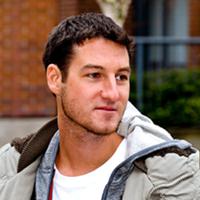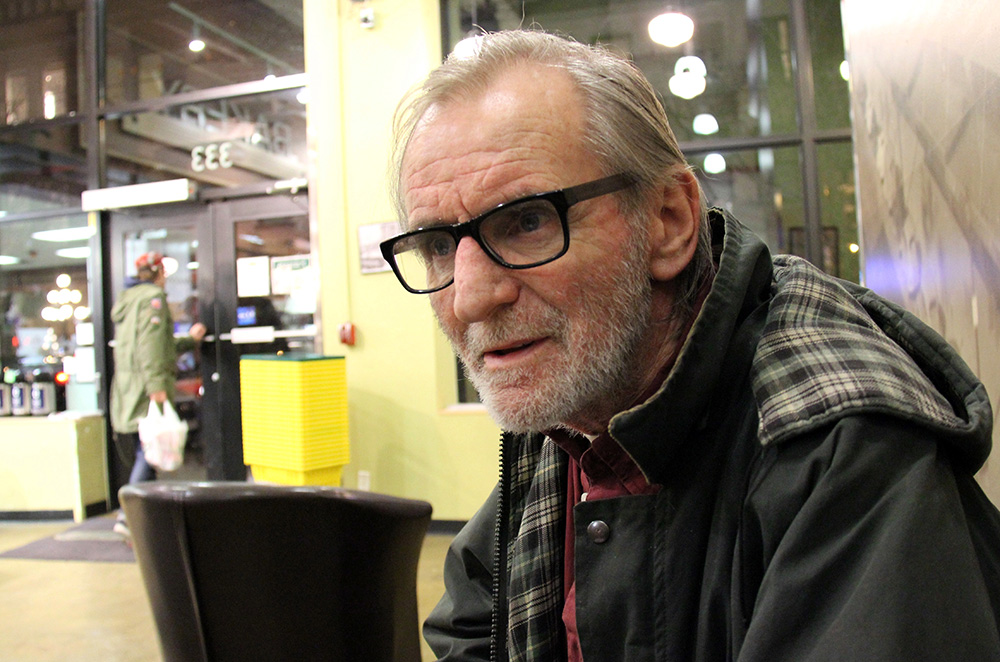In an essay written when he was 11 or 12 years old, David John Murray wrote that when he grew up, he wanted to be a scientist.
“We are involved with space and many diseases that have no cure known,” his childish lettering reads. “We need good scientists to solve the globe’s problems.” Murray knew it would be hard work, the essay continued, but he wanted to make the world a better place.
“I like chemistry very much and I am sure I would like to work on the space ships and all the problems of outer space. I hope I will be on the team to reach the moon.”
Life took him down another path. Murray never completed high school, notes an affidavit submitted to BC Supreme Court. He discovered hard drugs when he was still just a teenager and spent the rest of his life addicted to heroin. There were periods of homelessness and years in prison in the 1970s for his role in a bank robbery.
So Dave never became a scientist. At 62, however, he did fulfill a part of that childhood dream. In January 2013 Murray’s name appeared in the academic publication Harm Reduction Journal at the top of a research paper he co-authored with University of Victoria professor Susan Boyd. Another half dozen papers published in various academic journals followed.
Murray was unconscious and nearing death when the last of them made it to print in the International Journal of Drug Policy in April.
“Dave read the proof but he never got to see the actual article in his hands,” Boyd said in a telephone interview. “He was an amazing activist, but he was also a scholar.”
Boyd and Downtown Eastside activist Ann Livingston were at Murray’s bedside at St. Paul’s Hospital in the days leading up to his death from antibiotic-resistant septicemia on May 7.* He was 68.
He was unresponsive by that time, but Boyd and Livingston played old Bob Dylan and Rolling Stones albums for him along with favourite songs like Eric Clapton’s “Layla” — the unplugged version — and Van Morrison’s “Into the Mystic.”
On road trips, Boyd and Livingston recounted in separate interviews, Murray would “crank the music until the car vibrated” and often sang along. “He loved music,” Livingston said.
Murray began to grow frail more than a year ago. You could still find him around Vancouver’s Downtown Eastside, usually wearing a zip-up hoodie over a short-sleeve button-up shirt and eyeglasses held together with tape, newspaper tucked under one arm.
But he was showing up at fewer community meetings and skipping the sort of loud protests he once attended with a fist raised in the air. His influence in Vancouver remained, however, and continues strong as ever today.
In response to British Columbia’s twin health crises — the COVID-19 pandemic and the overdose epidemic, which was officially declared a public-health emergency in April 2016 — health officials have deployed a controversial response called “safe supply.”
Under a provincial directive, doctors are supplying people addicted to street drugs with pharmaceutical alternatives like hydromorphone (an opioid like heroin) and dextroamphetamine (a stimulant like cocaine). The idea is to tackle the spread of COVID-19 by removing the need to seek drugs on the street and reduce overdose deaths by providing people with a consistent supply of drugs of known purity as opposed to unknown substances that probably contain fentanyl.
It’s a partial solution to both health emergencies that harm-reduction advocates are calling a step toward an end to the war on drugs.
And, unknown to most citizens even in Vancouver’s close-knit Downtown Eastside, it’s an idea that got off the ground in Vancouver largely thanks to Dave Murray.
From 2006 to 2008, Murray participated in a clinical trial of prescription diacetylmorphine, the medical term for heroin. Called the North American Opiate Medication Initiative, the experiment conducted at the Downtown Eastside’s Crosstown Clinic assessed whether heroin-assisted treatment could stabilize patients who had repeatedly failed with traditional addiction treatments like abstinence and methadone.
The academic papers that came out of NAOMI say that the treatment is effective for some people, resulting in improved physical and mental-health outcomes, fewer interactions with the criminal-justice system and secondary benefits such as access to stable housing.
That was true for Murray. He gained weight, felt notable improvements in his depression and reconnected with family. But when NAOMI ended in 2008, Murray and everyone enrolled in the experiment were cut off from those prescription drugs and forced to return to the alleys.
“I was back on the street doing a lot of heroin again,” Murray told me in a 2017 interview. “The heroin wasn’t working. I was doing a lot of pills. Anything to keep the edge off. I went into detox. I tried to kick it cold turkey. I went into a treatment house. And then I was back out on the street again. I tried to get serious about not using again but nothing seemed to work.”
Murray and his fellow former-NAOMI subjects were denied a pharmaceutical drug that they knew had worked for them. That was wrong, he decided.
And so when a second research project, the Study to Assess Longer-term Opioid Medication Effectiveness, prepared to launch in 2011, Murray got to work organizing. “We knew we had to start collaborating with the people that were planning SALOME,” he said. “We told them we were going to be involved.”
By this time, Murray was active with the Vancouver Area Network of Drug Users and the B.C.-Yukon Association of Drug War Survivors. That work saw him travel around the province with VANDU’s co-founder, Ann Livingston.
Often stuck in the car together for hours, they brainstormed how Murray and his fellow “research subjects” could ensure they got a say in how SALOME took shape. Murray connected with Boyd and invited her to VANDU’s office on East Hastings Street, where he had assembled what he called the NAOMI Patients Association, later renamed the SALOME-NAOMI Association of Patients.
Under Dave’s soft-spoken leadership and armed with Boyd’s research expertise, the group demanded a say in how SALOME would operate and, crucially, they secured a promise that participants for whom diacetylmorphine worked would continue to receive the drug after the trial ended.
“There are many documents about including the voices of people who use illicit drugs [in research], but oftentimes, they bring them in at the end or just as consultants,” Boyd said. “This was unique because it was right from the start, it was their idea, and it was driven by the group.”
It wasn’t a straight line to victory. The former federal government of Stephen Harper opposed the programs and Murray and four other SALOME patients ultimately went to court to secure Crosstown Clinic’s survival.
But eventually, in 2014, the facility’s lead physician, Dr. Scott MacDonald, transitioned from an academic study to a fully-fledged program. It had taken nearly half-decade of weekly meetings at VANDU, but Dave and his band of drug users won.
In the years that followed, other Vancouver physicians like Dr. Christy Sutherland pushed what the province was now calling “safe supply” further, expanding access to hydromorphone.
In 2016, Sutherland deployed the pharmaceutical alternative in response to Vancouver’s overdose crisis, hoping that by offering it at her clinic she would spare patients from black market drugs adulterated with fentanyl.
And in March, B.C. Health Minister Adrian Dix issued guidance allowing physicians to further expand access to safe supply in response to the simultaneous threats of COVID-19 and overdose deaths.
Now top government officials including Vancouver Mayor Kennedy Stewart are lobbying for safe-supply programs to continue after the coronavirus has passed.
“Now, more than ever, we need to double down on this life-changing policy,” Stewart wrote in an April op-ed, continuing the conversation that started at VANDU with Dave’s group of prescription-heroin patients.
Beyond safe supply, Livingston said Murray’s larger impact was in giving a voice to people who use drugs.
“Every week was a full week,” she said. “We were always there for every single fucking meeting. That’s what we did. We went to everything.”
Dave never failed to read every report on the agenda for discussion, Livingston continued, and the footnotes and then the reports cited in those footnotes. “He was just a tremendously knowledgeable person and that came out at every meeting.”
Boyd said Murray made similar contributions with their collaborative research. (Dave’s late-in-life career as an amateur scientist).
“He wanted to contribute to knowledge around the issue of heroin-assisted treatment and he wanted to do that with the voices of people who had experience with heroin-assisted treatment or who had used criminalized drugs,” she said. “That was quite original. His work stands out.”
Since Murray’s passing, hundreds of memories and messages of condolence have flooded social media. Many are from prominent policymakers and politicians. Many more are from fellow activists in the movement praising his contribution.
“His resolve to make drug laws rational in this country will be remembered,” his friend and neighbour, Dean Wilson, wrote online.
“Take a break, Dave. I know the last six months have been tough. See you on the other side.”
*Story corrected on May 15 at 1:15 p.m. to reflect the correct date of Dave Murray's death. ![]()
Read more: Rights + Justice, Municipal Politics
















Tyee Commenting Guidelines
Comments that violate guidelines risk being deleted, and violations may result in a temporary or permanent user ban. Maintain the spirit of good conversation to stay in the discussion.
*Please note The Tyee is not a forum for spreading misinformation about COVID-19, denying its existence or minimizing its risk to public health.
Do:
Do not: